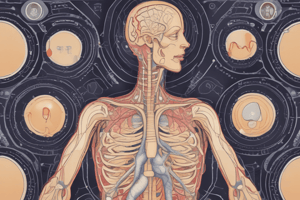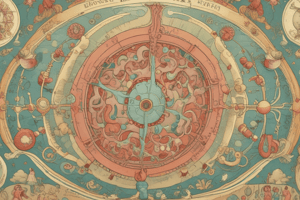Podcast
Questions and Answers
Which of the following hormones directly stimulates smooth muscle contractions?
Which of the following hormones directly stimulates smooth muscle contractions?
- Thyroid stimulating hormone (TSH)
- Antidiuretic hormone (ADH)
- Luteinizing hormone (LH)
- Oxytocin (OXY) (correct)
What is the correct order of events in the release of a tropic hormone from the anterior pituitary?
What is the correct order of events in the release of a tropic hormone from the anterior pituitary?
- Hypothalamus releases a releaser, target tissue produces hormones, anterior pituitary cell secretes a tropic hormone
- Anterior pituitary cell secretes a tropic hormone, hypothalamus releases a releaser, target tissue produces hormones
- Target tissue produces hormones, hypothalamus releases a releaser, anterior pituitary cell secretes a tropic hormone
- Hypothalamus releases a releaser, anterior pituitary cell secretes a tropic hormone, target tissue produces hormones (correct)
Which of the following is NOT a characteristic of the neurohypophysis?
Which of the following is NOT a characteristic of the neurohypophysis?
- Releases hormones that use the PIP mechanism of action
- Secretes hormones but does not produce them
- Composed of neural tissue
- Stimulated by the hypothalamus through releaser hormones (correct)
What is the primary function of antidiuretic hormone (ADH)?
What is the primary function of antidiuretic hormone (ADH)?
Which of the following is an example of a tropic hormone released by the anterior pituitary?
Which of the following is an example of a tropic hormone released by the anterior pituitary?
Which of the following is NOT a factor that controls hormone action?
Which of the following is NOT a factor that controls hormone action?
What is the primary role of adenylate cyclase in the cAMP mechanism?
What is the primary role of adenylate cyclase in the cAMP mechanism?
What is the role of phospholipase in the PIP-calcium mechanism?
What is the role of phospholipase in the PIP-calcium mechanism?
Which of the following is an example of permissiveness in hormone interaction?
Which of the following is an example of permissiveness in hormone interaction?
Which of the following is an example of synergism in hormone interaction?
Which of the following is an example of synergism in hormone interaction?
Which of the following is an example of antagonism in hormone interaction?
Which of the following is an example of antagonism in hormone interaction?
What is the primary mechanism by which the nervous system regulates hormone release?
What is the primary mechanism by which the nervous system regulates hormone release?
What is the function of phosphodiesterase in the cAMP mechanism?
What is the function of phosphodiesterase in the cAMP mechanism?
What is the effect of increased levels of glucocorticoids on the ACTH cascade?
What is the effect of increased levels of glucocorticoids on the ACTH cascade?
Which hormone stimulates the production of testosterone in males?
Which hormone stimulates the production of testosterone in males?
What is the primary function of Growth Hormone Inhibiting Hormone (GHIH)?
What is the primary function of Growth Hormone Inhibiting Hormone (GHIH)?
What is the primary function of Prolactin Inhibiting Hormone (PIH)?
What is the primary function of Prolactin Inhibiting Hormone (PIH)?
Which of the following is NOT a direct action of growth hormone?
Which of the following is NOT a direct action of growth hormone?
What is the primary function of Thyroid Releasing Hormone (TRH)?
What is the primary function of Thyroid Releasing Hormone (TRH)?
In the gonadotropin cascade, what is the role of GnRH (Gonadotropin-releasing hormone)?
In the gonadotropin cascade, what is the role of GnRH (Gonadotropin-releasing hormone)?
What is the effect of increased levels of gonadotropins on the gonadotropin cascade?
What is the effect of increased levels of gonadotropins on the gonadotropin cascade?
What is the primary function of prolactin?
What is the primary function of prolactin?
What is the relationship between PIH and prolactin during pregnancy?
What is the relationship between PIH and prolactin during pregnancy?
Which of the following statements accurately describes the difference between steroid and amino acid-based hormone actions?
Which of the following statements accurately describes the difference between steroid and amino acid-based hormone actions?
Which of the following is NOT a characteristic of steroid hormones?
Which of the following is NOT a characteristic of steroid hormones?
Which of the following is a key role played by G proteins in the action of amino-acid based hormones?
Which of the following is a key role played by G proteins in the action of amino-acid based hormones?
Which of the following is TRUE about the cyclic AMP (cAMP) mechanism in amino acid-based hormone action?
Which of the following is TRUE about the cyclic AMP (cAMP) mechanism in amino acid-based hormone action?
What is the primary difference between the cyclic AMP and the PIP-calcium mechanisms in amino acid-based hormone action?
What is the primary difference between the cyclic AMP and the PIP-calcium mechanisms in amino acid-based hormone action?
Which of the following is NOT a characteristic of endocrine glands?
Which of the following is NOT a characteristic of endocrine glands?
Which type of chemical messenger affects only the cell that secreted it?
Which type of chemical messenger affects only the cell that secreted it?
Which of the following is a characteristic of the nervous system that distinguishes it from the endocrine system?
Which of the following is a characteristic of the nervous system that distinguishes it from the endocrine system?
What is the primary function of the neuroendocrine link?
What is the primary function of the neuroendocrine link?
Which of the following actions can hormones NOT produce in target cells?
Which of the following actions can hormones NOT produce in target cells?
Which of the following is NOT a type of chemical messenger?
Which of the following is NOT a type of chemical messenger?
Which of the following statements about target cells is TRUE?
Which of the following statements about target cells is TRUE?
Which of the following best describes the relationship between the hypothalamus and the pituitary gland?
Which of the following best describes the relationship between the hypothalamus and the pituitary gland?
Flashcards
Amino Acid-Based Hormones
Amino Acid-Based Hormones
Hormones derived from proteins that are water soluble and cannot cross the plasma membrane.
Steroid Hormones
Steroid Hormones
Hormones derived from cholesterol that are lipid soluble and have receptors inside the cell.
Direct Mechanism
Direct Mechanism
Steroid hormone action where hormones diffuse through the membrane and activate gene expression.
Indirect Mechanism
Indirect Mechanism
Signup and view all the flashcards
Eicosanoids
Eicosanoids
Signup and view all the flashcards
Adrenal Glands
Adrenal Glands
Signup and view all the flashcards
Neurohypophysis
Neurohypophysis
Signup and view all the flashcards
Oxytocin
Oxytocin
Signup and view all the flashcards
Antidiuretic Hormone (ADH)
Antidiuretic Hormone (ADH)
Signup and view all the flashcards
Tropic Hormone
Tropic Hormone
Signup and view all the flashcards
Endocrine System
Endocrine System
Signup and view all the flashcards
Nervous System
Nervous System
Signup and view all the flashcards
Exocrine Glands
Exocrine Glands
Signup and view all the flashcards
Endocrine Glands
Endocrine Glands
Signup and view all the flashcards
Neuroendocrine Link
Neuroendocrine Link
Signup and view all the flashcards
Hormones
Hormones
Signup and view all the flashcards
Target Cells
Target Cells
Signup and view all the flashcards
Chemical Classifications of Hormones
Chemical Classifications of Hormones
Signup and view all the flashcards
Adenohypophyseal
Adenohypophyseal
Signup and view all the flashcards
Growth Hormone (GH)
Growth Hormone (GH)
Signup and view all the flashcards
Hypothalamus & GH
Hypothalamus & GH
Signup and view all the flashcards
Gigantism
Gigantism
Signup and view all the flashcards
Acromegaly
Acromegaly
Signup and view all the flashcards
Cascades of Hormones
Cascades of Hormones
Signup and view all the flashcards
Thyroid-Stimulating Hormone (TSH)
Thyroid-Stimulating Hormone (TSH)
Signup and view all the flashcards
Adrenocorticotropic Hormone (ACTH)
Adrenocorticotropic Hormone (ACTH)
Signup and view all the flashcards
Gonadotropins
Gonadotropins
Signup and view all the flashcards
Prolactin
Prolactin
Signup and view all the flashcards
Cyclic AMP (cAMP) mechanism
Cyclic AMP (cAMP) mechanism
Signup and view all the flashcards
Hormone receptor binding
Hormone receptor binding
Signup and view all the flashcards
G protein activation
G protein activation
Signup and view all the flashcards
Phospholipase function
Phospholipase function
Signup and view all the flashcards
Permissiveness
Permissiveness
Signup and view all the flashcards
Synergism
Synergism
Signup and view all the flashcards
Hormonal regulation of release
Hormonal regulation of release
Signup and view all the flashcards
Endocrine gland examples
Endocrine gland examples
Signup and view all the flashcards
Study Notes
Endocrine System
- The endocrine system uses chemical messengers (hormones) that affect any tissue with a receptor for that specific chemical.
- Response is slower compared to the nervous system, taking days for action to occur.
- The nervous system uses neurons to send electrical signals (action potentials).
- This system stimulates muscles and glands, responding to stimuli very quickly, and has a short-lived effect.
Exocrine and Endocrine Glands
- Exocrine glands secrete hormones into ducts.
- Endocrine glands are ductless, secreting hormones directly into the bloodstream.
- Some organs have both endocrine and exocrine functions.
Neuroendocrine Link
- The neuroendocrine link involves stimulation by the hypothalamus, the major regulator for endocrine activity.
- The hypothalamus sends nervous and precursor signals to activate other endocrine glands.
Chemical Messengers
- Hormones are chemical messengers that affect another part of the body.
- Autocrines are chemicals produced by a cell to change the activity of that same cell.
- Paracrines affect neighboring cells.
- Local regulators act on nearby cells or tissues (e.g., prostaglandins, leukotrienes).
- Pheromones are produced by one individual, affecting another's behavior (sexual or repulsive).
Hormone Actions- Cellular Effects
- Hormones target cells with specific receptors on their cell surface.
- Hormones can have various effects, including opening or closing ion channels, changing membrane potentials, stimulating protein synthesis, and activating/deactivating enzymes.
- Hormones can also promote secretion of other substances.
Hormone Chemical Classifications
- Amino acid-based hormones are derived from proteins, usually water-soluble and cannot cross plasma membranes.
- Steroid hormones are lipid-soluble, derived from cholesterol, with receptors inside the cell.
- Sources of steroid hormones are the adrenal cortex and gonads.
- Eicosanoids are biologically active lipids that function locally but indirectly.
Mechanisms of Hormone Action
- Steroid hormones directly activate genes.
- Non-steroid hormones (amino acid-based) use an indirect mechanism involving secondary messengers like cyclic AMP (cAMP) and calcium ions (PIP-Calcium mechanism).
Hormone Action Regulation
- Hormone levels in the bloodstream, receptor quantity, and receptor affinity affect hormone action.
- Upregulation increases the number of receptors, while downregulation decreases them, often in response to stress.
- Three types of hormone interactions:
- Permissiveness: one hormone enhances the effect of another.
- Synergism: two or more hormones have a combined effect.
- Antagonism: two hormones have opposite effects.
- Hormone release is regulated by humoral (blood concentration), neural (nervous stimulation), and hormonal stimuli (hormones produced from another gland).
Major Endocrine Organs and Locations
- Pituitary gland- brain extension.
- Thyroid gland- surrounds the trachea.
- Parathyroid glands- embedded in the thyroid.
- Adrenal glands- on top of the kidneys.
- Pancreas (endocrine portion)- abdominal cavity.
- Gonads (testes/ovaries)- male/female reproductive organs.
- Pineal gland- brain.
- Thymus- active in young individuals.
Posterior Pituitary (Neurohypophysis)
- Composed of neural tissue, does not synthesize hormones but secretes them.
- Releases oxytocin (stimulates uterine contractions and milk ejection) and antidiuretic hormone (ADH) (regulates water balance).
Anterior Pituitary (Adenohypophysis)
- Composed of glandular tissue, secretes tropic hormones that stimulate other endocrine glands.
Growth Hormone (GH)
- Stimulates growth, cell division, protein synthesis, fat metabolism, and glucose conservation.
- Overactive GH leads to gigantism in children and acromegaly in adults.
- Insufficient GH causes pituitary dwarfism.
Thyroid Stimulating Hormone (TSH) Cascade
- Involved in thyroid hormone production and its regulation.
Adrenocorticotropic Hormone (ACTH) Cascade
- Involved in the production of corticosteroids by the adrenal cortex and the body's response to stress.
Gonadotropins
- Stimulate the function of gonads (testes & ovaries).
- Include follicle-stimulating hormone (FSH) and luteinizing hormone (LH), affecting sperm and egg production, and sex hormone production.
Prolactin
- Stimulates milk production and enhances testosterone production in males.
- High estrogen levels stimulate prolactin release, and prolactin production is brief due to ovarian hormone cycling.
- Suckling promotes sustained prolactin production.
Pro-opiomelanocortin (POMC)
- A precursor hormone involved in creating other hormones.
Studying That Suits You
Use AI to generate personalized quizzes and flashcards to suit your learning preferences.




